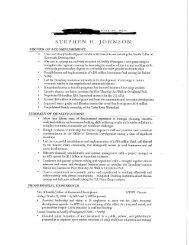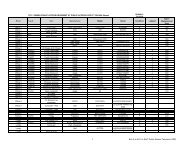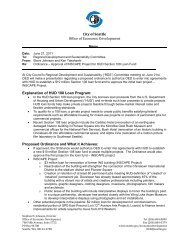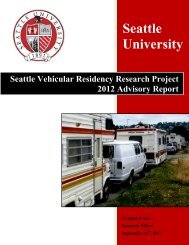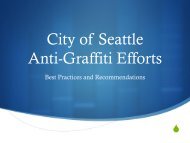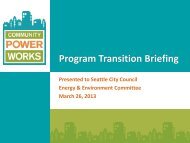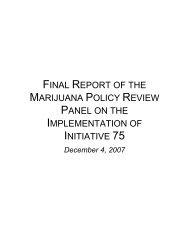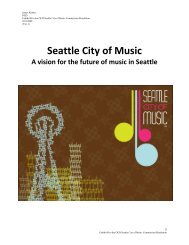2013 Water System Plan, Volume II - Seattle City Clerk's Office - City ...
2013 Water System Plan, Volume II - Seattle City Clerk's Office - City ...
2013 Water System Plan, Volume II - Seattle City Clerk's Office - City ...
Create successful ePaper yourself
Turn your PDF publications into a flip-book with our unique Google optimized e-Paper software.
<strong>Seattle</strong> Public Utilities<br />
Comprehensive Drinking <strong>Water</strong> Quality Monitoring <strong>Plan</strong><br />
February 2012<br />
1.0 Overview<br />
Providing public health protection is a primary concern in the operation and maintenance of a<br />
public drinking water system. Determining the adequacy of this protection is accomplished with<br />
a comprehensive monitoring program that covers the source of supply, treatment systems, the<br />
distribution system, and customers’ taps. Sampling requirements are established by federal<br />
regulations, such as the Safe Drinking <strong>Water</strong> Act (SDWA), which are in most cases adopted by<br />
the state. <strong>Seattle</strong> Public Utilities (SPU) conducts monitoring in accordance with the Safe<br />
Drinking <strong>Water</strong> Act and Washington State Department of Health requirements, Chapter 246-290<br />
WAC.<br />
This monitoring plan addresses the following:<br />
• Monitoring requirements under state and federal drinking water regulations;<br />
• Future regulations, which are currently under development at the federal level;<br />
• Non-regulatory monitoring, which SPU conducts for informational purposes and to<br />
assist in operating the water system;<br />
• Sampling procedures;<br />
• Laboratory Information Management <strong>System</strong> (LIMS); and,<br />
• All parameters, locations, and frequency of monitoring conducted by SPU.<br />
Monitoring locations include source, treatment, transmission and distribution system,<br />
and customer taps.<br />
A summary of SPU’s monitoring requirements is shown in Table 1. This table includes source<br />
water and distribution system monitoring required by regulation. Monitoring of treatment<br />
operations required by the Surface <strong>Water</strong> Treatment Rule or Lead and Copper Rule is not<br />
included in Table 1, but is discussed below, and is reflected in Table 2.<br />
Table 2 is a summary of the monitoring currently conducted by SPU and is organized by<br />
sampling locations, frequencies, and parameters. This table includes monitoring required by<br />
regulations, and monitoring conducted for operational or informational purposes (nonregulatory).<br />
All monitoring shown is directly related to the drinking water supply. Monitoring<br />
related to special studies, customer inquiries, disinfection of new mains, construction of<br />
facilities, environmental compliance when dewatering facilities, wellhead protection, aquifer<br />
recharge, source development, treatment chemicals, or other monitoring conducted for purposes<br />
other than drinking water quality compliance is not included in this document.<br />
DOH has the authority to grant waivers for certain parameters, depending on vulnerability and<br />
previous sampling results. If a system is considered to have low vulnerability to contamination<br />
from a certain chemical or group of chemicals, the State may waive the requirements for<br />
Comprehensive <strong>Water</strong> Quality Monitoring <strong>Plan</strong> Page 1 of 12



